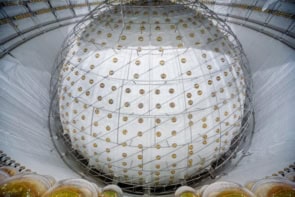Physicists at the KEK laboratory in Japan and the University of Hawaii have proposed a “futuristic but not necessarily impossible technology” that would use an ultra-high energy neutrino beam to destroy nuclear weapons. However, the researchers stress that the method is well beyond the capabilities of current particle accelerators and would require substantial R&D and financial investment by many nations (H Sugawara et al. 2003 arxiv.org/abs/hep-ph/0305062).
Neutrinos are one of the fundamental particles of matter and come in three ‘flavours’ – electron, muon and tau neutrino. They are electrically neutral and only interact weakly with matter, which means that they can pass through thousands of kilometres of matter without being absorbed.
In 1999 the first so-called long-baseline neutrino oscillation experiment, K2K, involved sending a neutrino beam from KEK to the Superkamiokande detector 250 km away. There are plans underway to send a neutrino beam from Fermilab to the Soudan lab in Minnesota, 710 km away and from CERN to Gran Sasso in Italy, 730 km away. The new method for destroying nuclear weapons proposed by Hirotaka Sugawara, Hiroyuki Hagura and Toshiya Sanami is a “vast extrapolation” of such experiments.
The researchers suggest sending a neutrino beam with an energy of 1000 TeV through the Earth to wherever the nuclear weapon was located (see figure). The beam would produce neutrons in a ‘hadron shower’ and would cause fission reactions in the plutonium or uranium in the bomb. These reactions would either melt or vaporize the bomb.
Such a high energy neutrino beam would be difficult to produce, the physicists admit. The storage ring would have to be 1000 km across – hundreds of times larger than the biggest present day accelerators. The magnets in the specially built muon storage ring would need to be one to two orders of magnitude stronger than those currently available to construct a realistically sized machine. Moreover, the cost of building such a device could be over $100 billion and it would consume 50 GW of energy – the entire power consumption of the United Kingdom.
Finally there is the risk, the authors point out, that the interaction of the neutrino beam with the bomb “could lead to a full explosion” instead of eliminating it.



